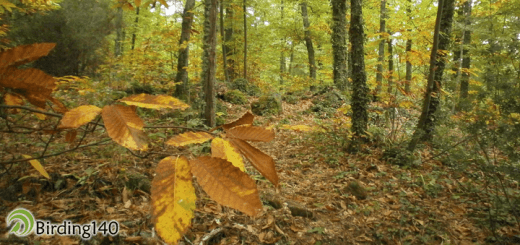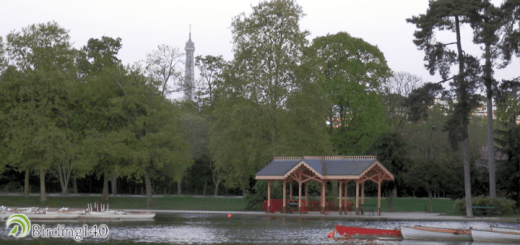Shetland is an archipelago formed by 117 islands, only 13 of which are inhabited by men. They are sited in a strategic location between Iceland, the Norwegian west coast and Great Britain. The North Sea surrounds its eastern coasts, while the Atlantic Ocean surrounds the western coasts. As they are very close to the polar circle, 60º North, they have sun light almost all day in summer. In winter, however, they hardly receive five and a half hours of light. Despite their apparently desolate landscape, the Shetland Islands hide a great beauty: the northern lights and the most spectacular cliffs in Great Britain. These can reach up to 369 metres above sea level.
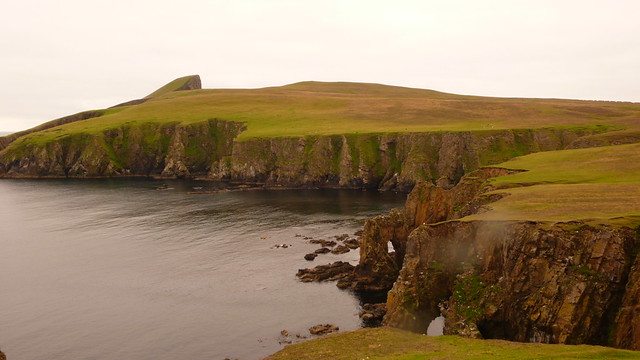
North Haven, Fair Isle | Author: CaptainOates · Creative Commons: Attribution 2.0 Generic
Shetland has a great ornithological diversity. It is a paradise for birdwatchers due to the large number of sea birds that nest in the islands, and because it is an important resting spot for migratory birds. Numerous rarities are spotted every year, reaching up to 363 different species.
The Northern Fulmar started nesting in 1878 and it is nowadays the most abundant bird in the Shetland Islands, with more than 180 000 couples. The archipelago also hosts half the world population of Great Skua, and the largest British concentration of Red-necked Phalarope is located in the island of Fetlar.
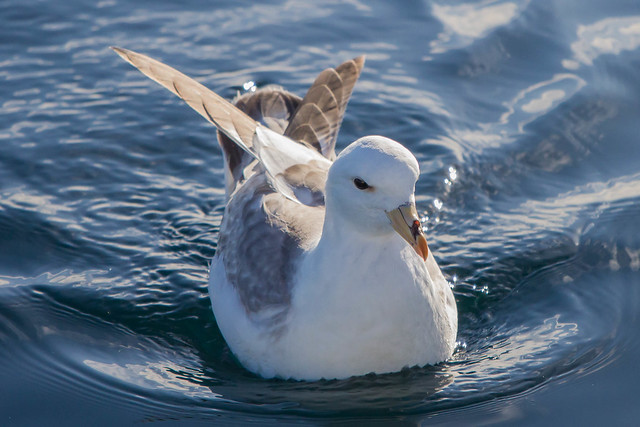
Northern Fulmar (Fulmarus glacialis) | Author: Dawn Beattie · Creative Commons: Attribution 2.0 Generic
The best time to visit the Shetland Islands is between May and June, since we can see an impressive number of nesting sea birds. However, if we want to see migratory birds or rarities, we should visit the islands in autumn. To get a clear picture of the great possibilities of these islands, we can enumerate some of the species that were reported between 1972 and 1995: Black-browed Albatross, King Eider, Harlequin Duck, Little Bustard, Great Knot, Ivory Gull, Ross’s Gull, Snowy Owl, Northern Hawk-Owl and Rüppell’s Warbler.
If we visit the Shetland Islands, the best lodging place is Lerwick, in the Isle of Mainland and capital of the archipelago. From there, connections with the rest of the islands are easy. Without leaving Mainland, we can visit really impressive places, like the Pool of Virkie, where we can see Great Knots; the Loch of Hillwell, where we can find Palla’s Sandgrouses and White-throated Needletails; and Tresta Voe, a good place to find King Eiders. However, the must-see place is the reserve of Sumburgh Head, located in the south of Mainland, very close to the airport. We can find endless sea birds in its cliffs: puffins, murres, razorbills, gannets, fulmars, Great Skuas and Parasitic Jaegers… The accumulation of birds is such that the “noise” in the area is deafening.
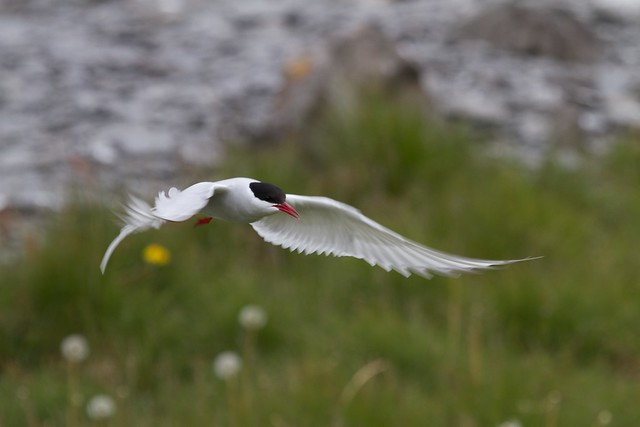
Arctic Tern (Sterna paradisaea) | Author: Brian Gratwicke · Creative Commons: Attribution 2.0 Generic
In the Isle of Unst, the most northerly of the archipelago, we can find the reserve of Hermaness, which hosts one of the largest colonies of sea birds in the United Kingdom. There we find a great number of Northern Gannets and Great Skuas. We can also watch Black Guillemots, fulmars, European Shags, Artic Terns, puffins and many more.
The isle of Noss is another one of the treasures of Shetland: the whole island is a spectacular reserve of sea birds. Noss can only be accessed with an inflatable boat from the neighbour island of Bressay: this strange “ferry” service that links the two islands, hardly separated by 500 metres, is available between May and August, whenever the weather allows it. Once we have disembarked, as we approach the East coast we can see more and more birds, until we reach the cliffs, where we can admire an enormous colony of sea birds with more than 50 000 couples: Common Murres, Northern Gannets, Great Skuas and Parasitic Jaegers…

Northern Gannet (Morus bassanus) | Author: Matt Tillett · Creative Commons: Attribution 2.0 Generic
The smallest main island of the archipelago is Fetlar, which hides several surprises. In addition to the greatest British population of Red-necked Phalarope, it contains rarities like the Common Yellowthroat in spring or the Chestnut-sided Warbler in autumn.
In the island of Moussa we can find one of the most peculiar images of the Shetland Islands. During summer, every midnight, we can see how the European Storm Petrels arrive to their nests located in “The Broch of Moussa”. It is an impressive tower built during the Iron Age, around 3 000 years ago.
If we are looking for rarities, there are three islands we should visit: Fair Isle, Foula and the small archipelago of Out Skerries. They are the most remote islands of the archipelago, and an real magnet for migratory birds. Gannets, fulmars, Artic Terns, European Shags, Black-legged Kittiwakes and many other species nest in these remote islands. In Foula we can also find the largest colony of Great Skua in the world, with about 2 500 couples.
There is no doubt the Shetland Islands are a dream come true for birdwatchers. In a week you can see about a hundred different species and take photos of many of them, for example the puffin, just a couple of metres away. To sum up, it is an authentic paradise dotted with cliffs and northern lights.
If you have enjoyed this post please share it on your social networks.

